"One Pitch - One Putt!". Successfully Pitching your Idea in front of Investors....
Prepare a successful Pitch
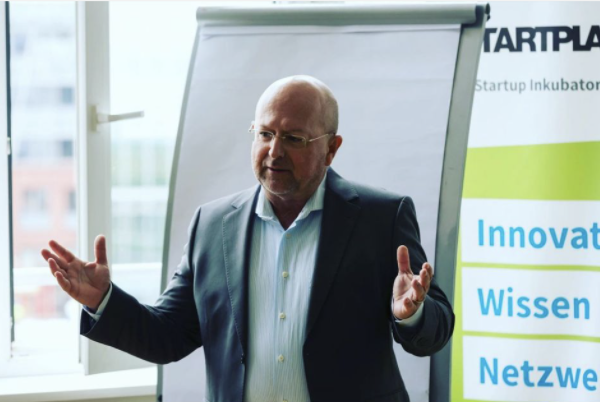
What do an investor pitch and golf have in common?
When you play Golf one very important shot is called "pitching". This shot is usually performed from below 100 meters from the flag. Ideally one wants to pitch the ball so close as possible to the hole for a "tap in". This would be one Pitch one Putt. The same way, when you will be pitching your idea in front of your Investors you will want your Pitch so successful that you can directly engage with the Investor. This is also one Pitch one Putt.

Who could be the target audience for your Pitch?
The Audience can range from family, fools and friends, over potential partners, financial institutions (Banks, Grants,...), to investors (Business angels, Family offices, VCs, Private Equity Firms).
What is the genuine Goal of your Pitch?
You want first to generate interest, then motivate, convince and win funders for your startup by getting them accept the next step which is a 1 on 1 deep dive meeting.
What are the key elements to prepare a successful Pitch?
A successful Pitch encompasses three things:
- A well constructed story with a strong content
- Mastering your voice and body language
- Being on top of the location and the presentation technologies available

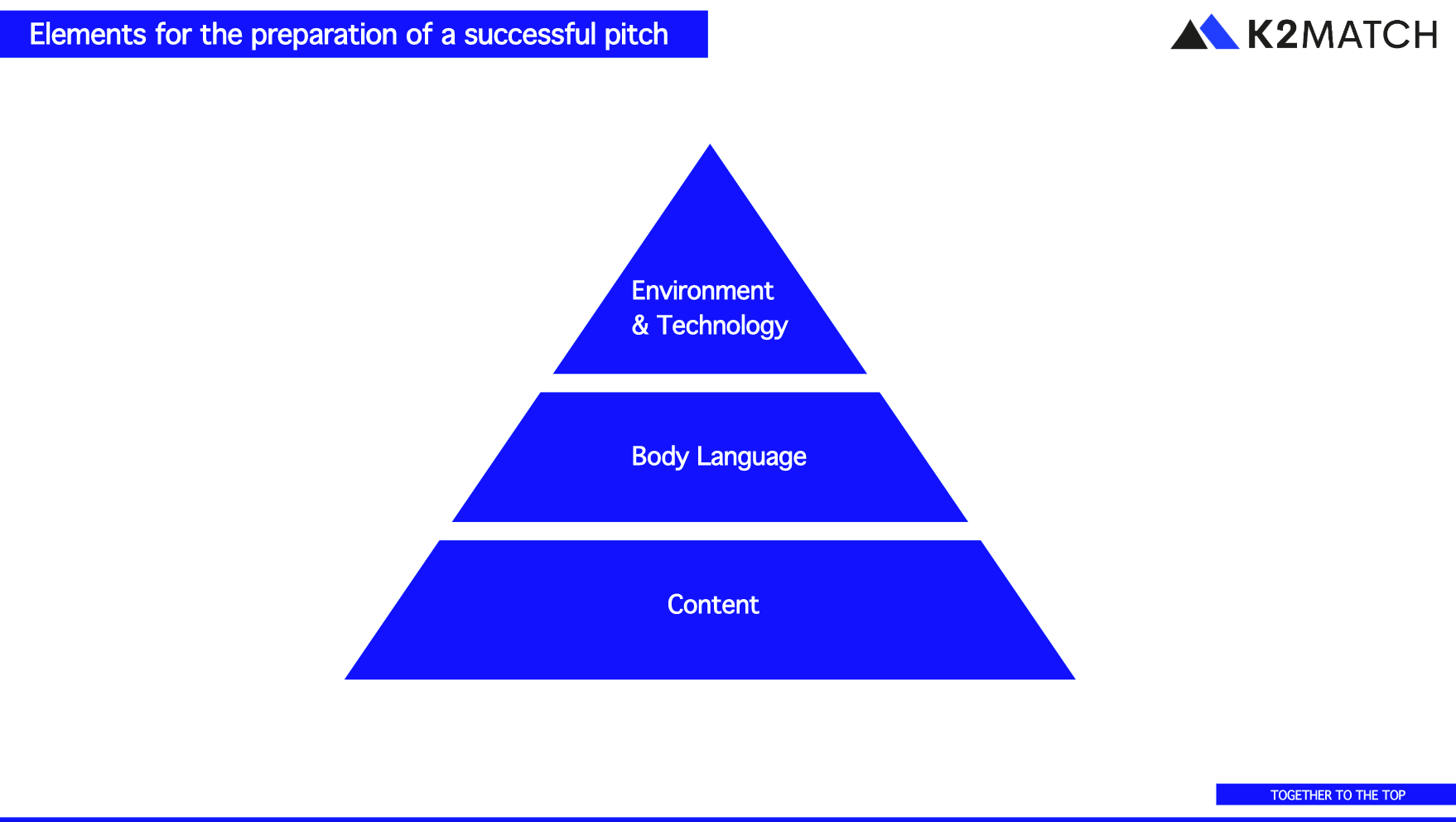
(1) Be on Top of the Environment & Technology
When it comes to the location and technology you need to be there early enough to have a feeling of the place and check the technology available (Laptop, Software, File, Beamer, Internet access, Sound etc...)
The other recommendation for your Pitch Deck is the 10 - 20 - 30 Rule:
- 10 slides
- 20 minutes maximum
- 30 font size
- Less is more ! This means less text, more schematic and pictures
- 10 slides pitch is ideal. Never more than 15 slides!
(2) Use your Voice and Body Language properly
There are many trainings out there for this part. This would be too long to describe here. However your stance, the position and movement of your hands and arms and your overall movements are an important vehicle to capture the attention of your audience and to convey your message. Your voice is the most important vector for your presentation, here you will need to understand and know where to accelerate and where to slow down your tempo. You will also need to plan where to be louder and where to put voluntary put a silent pause.
(3) Its all about Story Telling: Content, Structure, Scenario and Dramaturgy
You will need to Pitch to the point with Enthusiasm and Emotion. The story line of your pitch needs to constantly capture the attention of your audience, delivering a story that delights the heart and satisfies the wallet. The audience will need to love your idea and be convinced that they can make money with it. Therefor you need a professional structure. This means a presentation plan with an opening phase, a body phase and a closing phase. You will need a core message that you repeat at the beginning of each phase.
This is an example if I was going to present the content of this article.
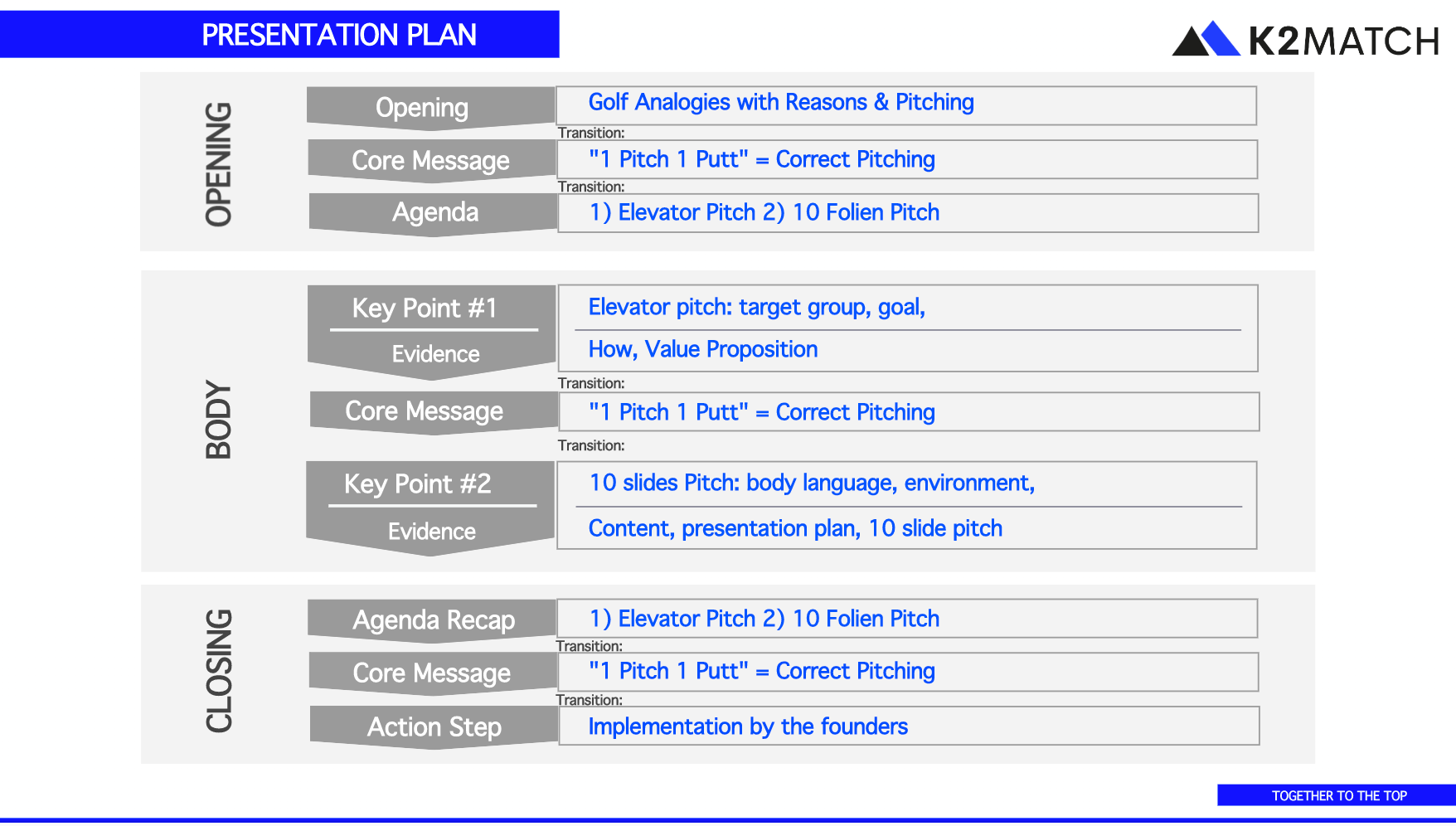
How should you do the Opening? Anecdotical, Emotional, Analytical or Rational?
It is always better to start with a beautiful and emotional story with pictures, metaphors and analogies, rather than with too many numbers - facts - data!
By doing so your Story creates Emotions resulting in Sensory impressions, leading to a message that fixes itself in the brains of your audience!
The more sensory impressions are linked to the image, the better. (= The right hemisphere of the brain controls more intuition, creativity, symbols and feelings. This brain hemisphere is activated by activated by metaphors, through which the listener's own, matching images, symbols images, symbols, melodies or smells can arise).
Use your Core message as a memory aid
Your core message should be brought to the point. Your core message is like a Slogan that you will repeat in each phase of the Pitch. Remember Martin Luther King's most well-known speech where he regularly repeated his core message: "I have a dream!"
Further examples are:
- Nike: "Just Do it"
- BMW: "Driving pleasure"
- Ritter Sport: "Square practically good"
- In our Pitching Training we use: "One Pitch - One Putt"
Ask yourself what is your core message ?
Read now, how to communicate better - with Nils Michaelis:
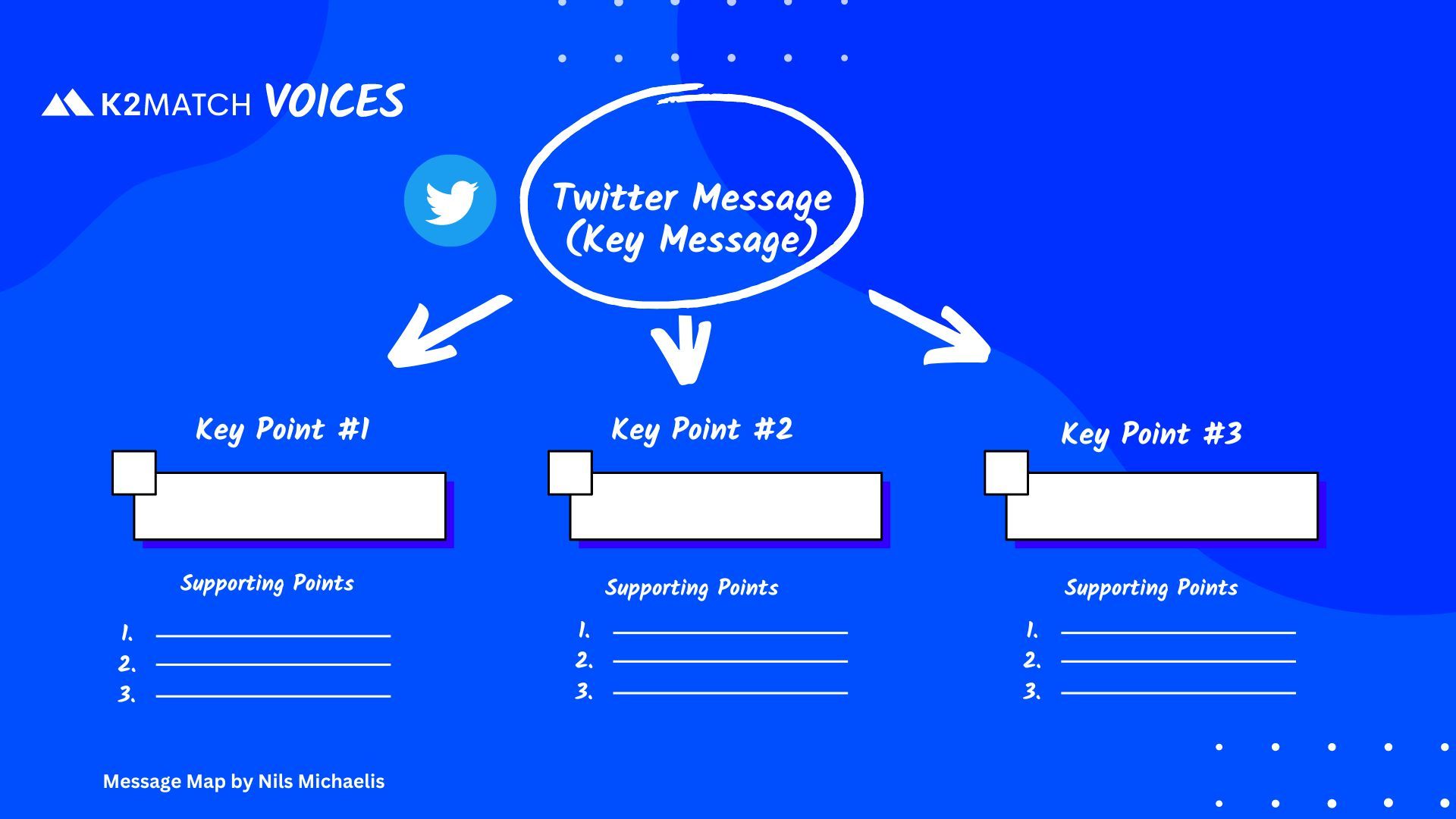
How to structure the 10 slide pitch?
To be remembered you will follow the (10-20-30 Rule). See above.
Here are now the titles for each of your 10 slides:
- Title
- Problem
- Value Proposition
- The Magic Behind
- The Business Model
- The Go-To-Market Plan
- The Competitive Analysis
- The Management Team
- The Financial Forecast
- The Status Quo? / The Future?
Now that you have the titles, you need to fill the slides.
Slide Number 1: Title
Here you mention your company name, you write your core message, your name & title, your address and contact details.
Slide Number 2: Problem / Opportunity
Here you need to describe the "customer pain" that you are curing with your solution and how you are doing it.
You have also the opportunity to describe the "pleasure" you are are providing your clients with your solution.
Slide Number 3: Value Proposition
Here you need to describe the VP = Value Proposition of your offering. How much value has the pain reduction for your client and how much value has the joy you are providing him.
Slide Number 4: The Magic behind
Describe the technology, the "secret spice" or magic behind your product or solution ! Use rather little text, but more diagrams, schematics or flowcharts! If you have a picture, a prototype or a demo, this is the right moment to show or demonstrate it to show or demonstrate it !
Slide Number 5: The Business Model
Describe who has "your money" in his pocket at the moment and how this money will transfer to your pocket.
Slide Number 6: The Go-To Market Plan
Explain how you will reach your customers without completely raiding your war chest. Describe your Marketing Strategy & Marketing Plan, as well your Sales strategy & sales plan.
Slide Number 7: The Competitive Analysis
Here you need to provide a very detailed overview of your competitive landscape. You better give too much information, rather than too little. Here you can use tools, such as the Porter's Forces and the SWOT analysis.
Slide Number 8: The Management Team
Describe the key roles in your management team including advisory board, as well as your current investors.
Slide Number 9: The Financial Forecast / KPIs
Here you need to produce a 3 years Financial Plan (Sales numbers, Costs, Margin, Cashflow,...) not only with € values, but also with other important key figures supporting the business plan. Important key figures can be: Number of customers; conversion rates. The Forecast needs to be build based on the key performance indicators of your business first and not the other way around.
Slide Number 10: The Status Quo? / The Future?
Describe your current status: e.g: Status of development,... Then you describe your timeline and your needs.
- How will your product look like in the near future ?
- How much money do you need?
- How and what for will you use the money?

The Essence of the 10 slide Pitch
The problems of the target customers exist and you have a unique and sustainable solution for them! You know our market and our competition; and you have a solid, complete and traceable "GoTo Market" strategy. Your management team is skilled and capable of managing the product development and marketing. There is a lot of money to be made for those who participate !
The 5 typical mistakes to avoid when pitching
- Not knowing your audience !
- Being too dependent on the slides !
- Claiming there is no competition !
- No data & facts available !
- Forgetting next steps !
The 5 best tactics to master when pitching
- Make a connection to the heart of your audience!
- Make a connection to the head (wallet) of your audience !
- Tell a Value-added story !
- Show the Team dynamics !
- Communicate to your audience that there is a lot of money to be made.
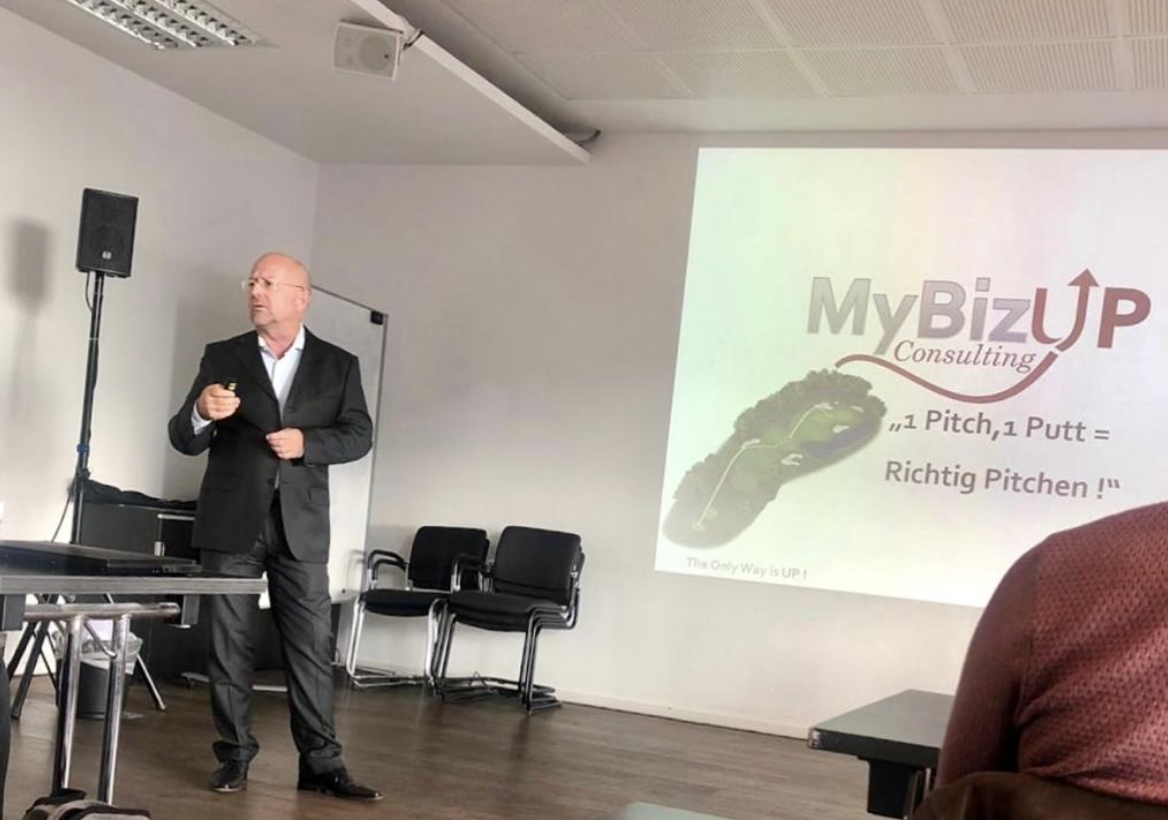
The Article was provided by MyBizUP Consulting and K2MATCH


